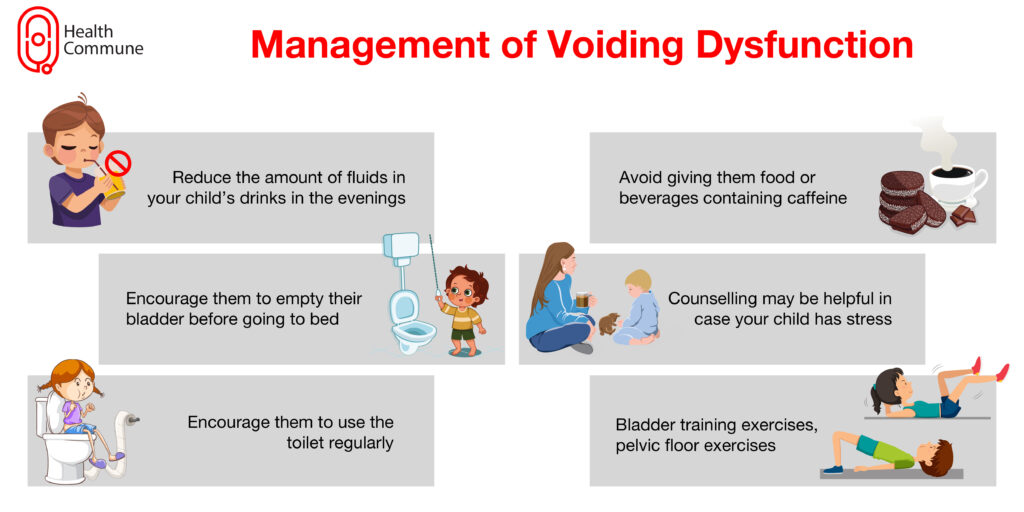Is your child having problems urinating? It could be a sign of voiding dysfunction. Read on to know about what it is, what causes it, and how it is diagnosed and treated.
What is voiding dysfunction?
Simply put, voiding dysfunction means that your child is not able to empty their bladder normally. There may be several reasons for this, including waiting too long to urinate, passing urine too frequently, or trying to urinate while the muscles that prevent urination are still closed. Based on the cause, your child’s symptoms will also vary. This condition can be confusing and worrisome to parents, teachers, and sometimes even doctors, who may label the child as immature or lazy.
What is normal voiding? What happens in voiding dysfunction?
Normally, when the bladder fills up, the sphincter muscle contracts, preventing the passage of urine. During urination, the opposite happens as the bladder contracts and the sphincter muscle relaxes, causing urine to pass.
This mechanism develops with time and is not seen in infants, so their bladder fills and empties without control. However, as they grow up, they start to gain control over their bowel movements around 3 years of age, and by the time they reach 4 years, they achieve bladder control as well. This control (where your child becomes “toilet trained” or “potty trained”) happens through signals from the brain to the bladder.
However, if your child is unable to learn this control, they may contract their sphincter muscles at the same time that the bladder contracts, leading to voiding dysfunction. In most cases, this occurs between 3-7 years of age, and once it begins, it is hard to unlearn.
How is voiding dysfunction caused?
It can be caused by a variety of factors, including:
- Your child could be engrossed in some other activity and, as a result, be waiting too long before finally going to the toilet
- Your child may not be emptying their bladder completely while urinating
- Your child may be suffering from anatomical abnormalities such as vesicoureteric reflux (VUR), spina bifida, ectopic ureter, etc.
What’s the connection between voiding dysfunction and constipation?
Constipation is frequent in children with voiding dysfunction. It is most likely explained by the fact that the same muscle groups control urination and bowel movements. However, unlike adults, children are usually not aware of or vocal about constipation. Your child may be suffering from constipation if they are not passing motions regularly, if you find streaks of stool in their underwear, or if they are constantly or repeatedly complaining of stomach pain.

What are the symptoms of voiding dysfunction?
Your child can experience:
- Inability to hold urine during the day as well as nighttime
- Trouble or straining while passing urine or dribbling urine
- An increase or decrease in the frequency of passing urine
- A sudden, strong urge to pass urine
- Constipation
- Abdominal pain
- Blood in the urine
What are the complications of voiding dysfunction?
How is dysfunctional voiding diagnosed?
Your child’s doctor will take a complete history of the symptoms and do a physical examination to determine the nature of the problem, what kind of treatment your child requires, and to rule out any neurological or anatomical defects.
- Aside from any obvious symptoms, they can evaluate for social, emotional, and behavioural problems that might prevent effective behaviour management
- Under physical examination, they will check for signs of faecal loading, constipation, spina bifida, and other forms of neurogenic bladder
- They will do a urological examination of the genital region and vagina and check for any signs of an ectopic ureter
- To confirm the diagnosis, their doctor may ask for:
- A 3-day bladder and bowel diary to track your child’s bowel and bladder movements
- Blood testing to check for diabetes, hormone problems, or other medical disorders
- Urine testing (urinalysis and culture/sensitivity) to identify any kind of infections, to check for diabetes or any other health conditions
- Urodynamic testing to check the functioning of your bladder and sphincter muscles
- Imaging studies such as an ultrasound, voiding cystogram, etc.
How is voiding dysfunction treated?
It can take anywhere from 6 months to 3 years for your child to resume normal voiding function. Stay patient, since the outcome for your child, if properly managed, is very good. Family support is very critical. Some simple changes that you can implement include:
- Reduce the amount of fluid your child drinks in the evenings
- Encourage them to empty their bladder twice before going to bed
- Encourage them to use the toilet regularly during the daytime, or create a schedule to regulate their habits
- Avoid giving them food or beverages containing caffeine
- Counselling can be helpful in case your child is suffering from some sort of stress or has experienced a traumatic event
Additionally, their doctor can recommend:
- Bladder training exercises, where your child is made to go to the bathroom on a fixed schedule in order to ’train’ their bladder
- Pelvic floor exercises, where your child consciously trains their pelvic floor muscles to contract, relax, and pass urine more easily
Sometimes, your child may need medications to help control their overactive bladder. Botulinum toxin has been shown to have a positive effect on some children. Rarely, surgery may be necessary in case your child is suffering from any anatomical defects.



